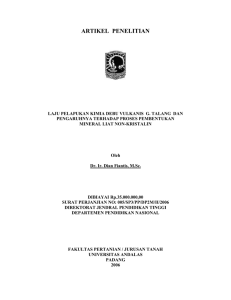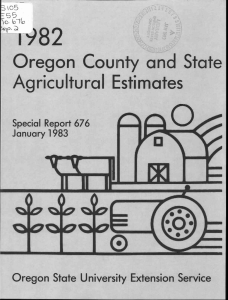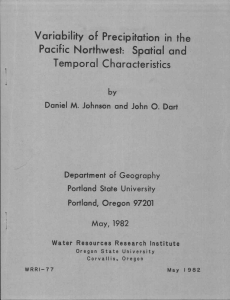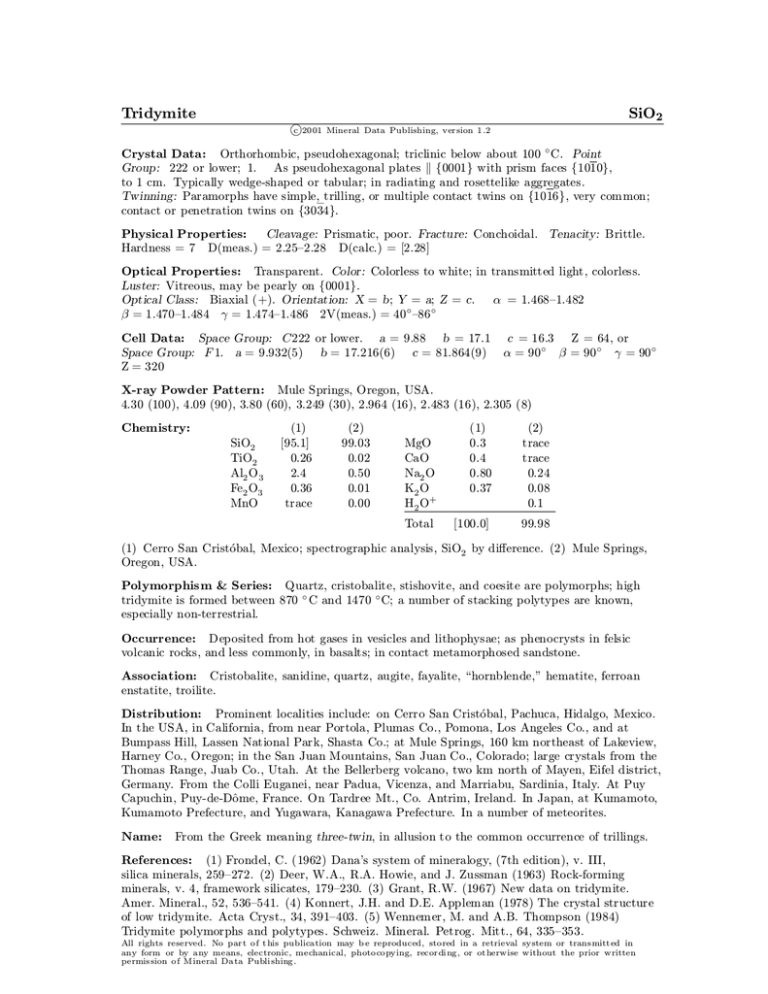
Tridymite
SiO2
°
c 2001
Mineral Data Publishing, ver sion 1.2
Crystal Data: Orthorhombic, pseudohexagonal; triclinic below about 100 ± C. Point
Group: 222 or lower; 1: As pseudohexagonal plates k f0001g with prism faces f1010g,
to 1 cm. Typically wedge-shaped or tabular; in radiating and rosettelike aggregates.
Twinning: Paramorphs have simple, trilling, or multiple contact twins on f1016g, very common;
contact or penetration twins on f3034g.
Physical Properties:
Cleavage: Prismatic, poor. Fracture: Conchoidal. Tenacity: Brittle.
Hardness = 7 D(meas.) = 2.25{2.28 D(calc.) = [2.28]
Optical Properties: Transparent. Color: Colorless to white; in transmitted light, colorless.
Luster: Vitreous, may be pearly on f0001g.
Optical Class: Biaxial (+). Orientation: X = b; Y = a; Z = c. ® = 1.468{1.482
¯ = 1.470{1.484 ° = 1.474{1.486 2V(meas.) = 40 ± {86 ±
Cell Data: Space Group: C222 or lower. a = 9.88 b = 17.1
Space Group: F 1: a = 9.932(5) b = 17.216(6) c = 81.864(9)
Z = 320
c = 16.3 Z = 64, or
® = 90 ± ¯ = 90 ± ° = 90 ±
X-ray Powder Pattern: Mule Springs, Oregon, USA.
4.30 (100), 4.09 (90), 3.80 (60), 3.249 (30), 2.964 (16), 2.483 (16), 2.305 (8)
Chemistry:
SiO2
TiO2
Al2 O 3
Fe2 O3
MnO
(1)
[95.1]
0.26
2.4
0.36
trace
(2)
99.03
0.02
0.50
0.01
0.00
MgO
CaO
Na2 O
K2 O
H2 O+
Total
(1)
0.3
0.4
0.80
0.37
(2)
trace
trace
0.24
0.08
0.1
[100.0]
99.98
(1) Cerro San Crist¶o bal, Mexico; spectrographic analysis, SiO2 by di®erence. (2) Mule Springs,
Oregon, USA.
Polymorphism & Series: Quartz, cristobalite, stishovite, and coesite are polymorphs; high
tridymite is formed between 870 ± C and 1470 ± C; a number of stacking polytypes are known,
especially non-terrestrial.
Occurrence: Deposited from hot gases in vesicles and lithophysae; as phenocrysts in felsic
volcanic rocks, and less commonly, in basalts; in contact metamorphosed sandstone.
Association: Cristobalite, sanidine, quartz, augite, fayalite, \hornblende," hematite, ferroan
enstatite, troilite.
Distribution: Prominent localities include: on Cerro San Crist¶o bal, Pachuca, Hidalgo, Mexico.
In the USA, in California, from near Portola, Plumas Co., Pomona, Los Angeles Co., and at
Bumpass Hill, Lassen National Park, Shasta Co.; at Mule Springs, 160 km northeast of Lakeview,
Harney Co., Oregon; in the San Juan Mountains, San Juan Co., Colorado; large crystals from the
Thomas Range, Juab Co., Utah. At the Bellerberg volcano, two km north of Mayen, Eifel district,
Germany. From the Colli Euganei, near Padua, Vicenza, and Marriabu, Sardinia, Italy. At Puy
Capuchin, Puy-de-D^o me, France. On Tardree Mt., Co. Antrim, Ireland. In Japan, at Kumamoto,
Kumamoto Prefecture, and Yugawara, Kanagawa Prefecture. In a number of meteorites.
Name:
From the Greek meaning three-twin, in allusion to the common occurrence of trillings.
References: (1) Frondel, C. (1962) Dana's system of mineralogy, (7th edition), v. III,
silica minerals, 259{272. (2) Deer, W.A., R.A. Howie, and J. Zussman (1963) Rock-forming
minerals, v. 4, framework silicates, 179{230. (3) Grant, R.W. (1967) New data on tridymite.
Amer. Mineral., 52, 536{541. (4) Konnert, J.H. and D.E. Appleman (1978) The crystal structure
of low tridymite. Acta Cryst., 34, 391{403. (5) Wennemer, M. and A.B. Thompson (1984)
Tridymite polymorphs and polytypes. Schweiz. Mineral. Petrog. Mitt., 64, 335{353.
All rights reserved. No par t of t his publication may b e reproduced, stored in a retrieval system or trans mitt ed in
any form or by any means, electronic, mechanical, photocopying, recor di ng, or ot herwise without the prior written
permis sion of Mineral Data Publi shing.

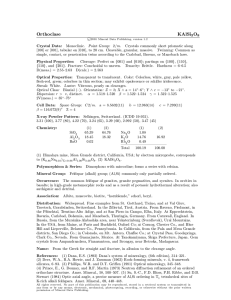

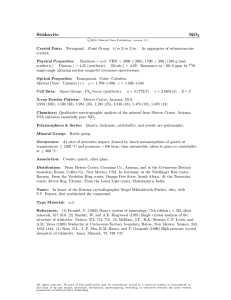
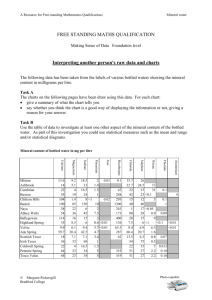
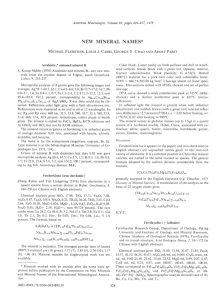

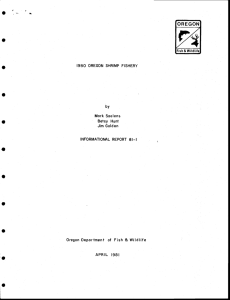
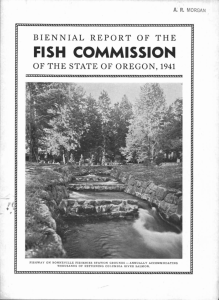
![REPOBT OF TIE ¶CHNICAL & COi!MITTEE OF IflE TRAWL FIRY... CO]D CONFERENCE ON COBDINATION OF FIHEIUE3 APPOINTED BY THE](http://s2.studylib.net/store/data/013325532_1-7edf6a7e257d82f21004d21e24be5f31-300x300.png)
